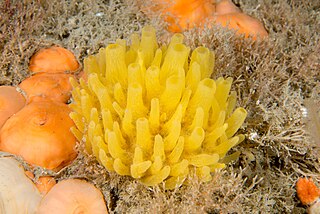
Polymastia is a genus of sea sponges containing about 30 species. These are small to large encrusting or dome-shaped sponges with a smooth surface having many teat-shaped projections (papillae). In areas of strong wave action, this genus does not grow the teat structures, but instead grows in a corrugated form.

Tethya is a genus of sea sponges belonging to the family Tethyidae. Members of this genus all have a spherical body form and some are known to be able to move at speeds of between 1 and 4 mm per day.

Auletta is a genus of sponges in the family Bubaridae.
Cladorhiza caillieti is a carnivorous sponge of the family Cladorhizidae described in 2014 from specimens collected from the Juan de Fuca Ridge off the coast of Vancouver Island. It feeds on small crustaceans such as amphipods and copepods. C. caillieti is an elongate, bottlebrush-shaped sponge with filaments projecting from a main stem, and ranges from 7 to 9 cm in height. The specific epithet honors Dr. Gregor M. Cailliet of the Moss Landing Marine Laboratories.
Amphidiscella lecus is a species of sea sponge first found at the bottom of shelf, canyon and seamounts of the west coast of Washington, British Columbia and the Gulf of Alaska.

Euplectellidae is a family of glass sponges (Hexactinellids) belonging to the order Lyssacinosa, first represented in the Ordovician fossil record, substantially older than molecular estimates of the clade's age.

Caulophacus is a genus of glass sponges belonging to the subfamily Lanuginellinae.

Staurocalyptus is a genus of sponge. It was circumscribed in 1897 by Isao Ijima.

Azoricidae is a family of marine sponges belonging to the order of Tetractinellida.
Acanthascus is a genus of sponges in the family Rossellidae. Species include:

Farrea is a genus of glass sponges in the family Farreidae.

Aspidoscopulia is a genus of glass sponge in the family Farreidae.
Claviscopulia is a genus of glass sponge in the family Farreidae.
Chonelasma is a genus of sea sponge in the family Euretidae.

Bolosoma is a genus of pedunculated siliceous sponges belonging to the family Euplectellidae. This genus lives in deep-sea environments and provides a habitat for a plethora of other benthic species, giving Bolosoma an incredibly important ecological role in the ecosystems it is a part of.
Poliopogon is a genus of sponges belonging to the family Pheronematidae.

Latrunculia is a genus of demosponges. It is well known for the diverse array of chemical compounds found in its species, including the latrunculins, which are named after this genus. Many of these are medically important, including anti-cancer compounds such as discorhabdins.
Amphidiscella hosiei is a species of glass sponge in the family Euplectellidae, first found in the Perth Canyon at a depth of 695 m, off the Western Australian coast.
Michelle Kelly, also known as Michelle Kelly-Borges, is a New Zealand scientist who specialises in sponges, their chemistry, their evolution, taxonomy, systematics, and ecology.










